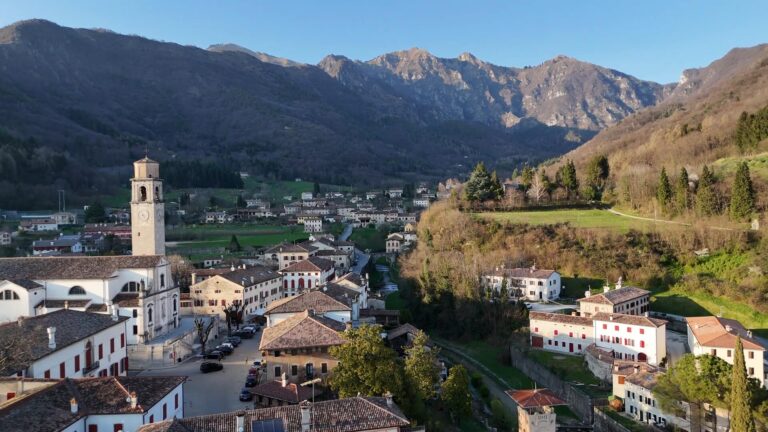ARTISTS’ ROADS
LE VIE DEGLI ARTISTI
watch the videos at the bottom of the page!
CISON DI VALMARINO
The Virtues of Marco Casagrande Watch Over Us
Cison di Valmarino lies at the heart of what was once the county of the Brandolini. Or rather, of the Brandoli counts from Bagnacavallo, who became the Brandolini in the Veneto. In 1433, Brando received this territory as a gift from the Serenissima for his military service. He shared it for three years with Erasmo da Narni, known as Gattamelata, who then ceded it permanently to the family from Romagna.
Brando and his descendants would go on to govern the Valmareno for a full 361 years, until 1797.
This land is a promise of wellbeing. A fertile valley, threaded with flowing streams. Sheltered to the north by the Prealps, where ancient mountain passes opened routes between the two sides.
Upon this land, the counts founded a self-contained world, exemplary in its economy, its administration, its society, and its culture.
Even today, the noble residences, the workshops, the mills, the cellars, and the majestic castle of the counts still speak of that golden age. They make Cison di Valmarino one of the most beautiful villages in Italy.
The historic centre is built around the archpriestal church, dedicated to the Assumption and to Saint John the Baptist. It stands on the site of an ancient parish church, rebuilt in the Baroque era. Its consecration dates back to 1746, and is owed to the bishop of Ceneda, Lorenzo da Ponte.
It is a refined structure, with a scenic presence, raised on high ground, and graced with two façades. The main one faces the castle. But the side overlooking Piazza Roma is just as striking, elevated by a monumental staircase.
Yet in 1746, its face was incomplete. It lacked a sculptural ensemble to lend grace and voice to its two fronts.
Its realisation would take over a century. In 1849, the ambitious project was entrusted to the sculptor Marco Casagrande, born in Campea di Miane in 1804, and by then, of international renown.
The master had just returned from Hungary, where for fifteen years he had stood at the pinnacle of the sculptural arts. Thanks to a most distinguished patron, Monsignor Giovanni Ladislao Pyrker, former Patriarch of Venice from 1820 to 1827, who had first recognised his talent in the lagoon city.
The two had met when Casagrande was a young student at the Accademia di Belle Arti in Venice. There, he was taught by Luigi Zandomeneghi, a pupil of Antonio Canova.
For the church of Cison di Valmarino, Casagrande began sculpting eight figures from the local stone of the Valle di San Daniele. He worked on them for two full years.
For the three niches on the main façade, he sculpted the Theological Virtues: Faith, Hope, and Charity. Three female figures, each with their traditional attributes. For Faith, the cross and the chalice, now lost. For Hope, the anchor. For Charity, three children. These are real women, not idealised. They wear nineteenth-century garments, and their faces are full of expression.
At the top of the façade facing Piazza Roma, Casagrande carved the Cardinal Virtues, grouped in pairs. Justice and Prudence to the left. Fortitude and Temperance to the right. Once again, four female figures, lifelike, of poignant beauty. Draped in flowing robes, with folds and gathers that play in light and shadow.
Justice, the queen of virtues, wears a crown upon her head. Prudence, the guide of human action, holds a serpent. Fortitude, who governs passions, grips a club. Temperance, who tempers earthly pleasures, pours water into wine with her two pitchers.
From above, they are steadfast, dynamic presences that have illuminated the Christian life of this community for more than 170 years.
With them stands Saint John the Baptist. From the central niche, he bestows his blessing, every single day.
MORE EXPERIENCES!
La scultura tra sacro e storia:
- L’altare dei Ghirlanduzzi nell’arcipretale di Cordignano
- Il Monumento ai Caduti di Segusino
- L’acquasantiera nell’arcipretale di Santa Lucia di Piave
- Due Santi di Franco Fabiane nell’arcipretale di Susegana
MULTIMEDIAL MAP: “ARTISTS’ ROADS – LE VIE DEGLI ARTISTI- EN”!

